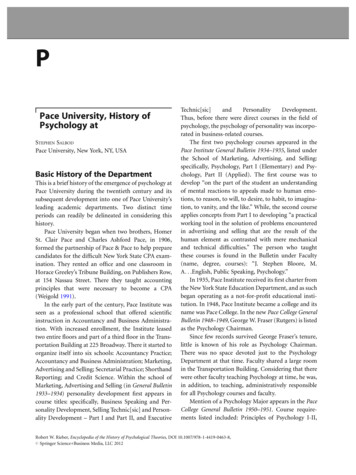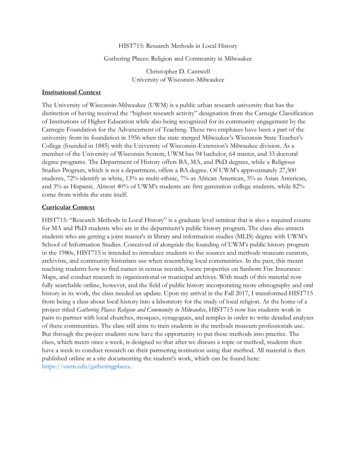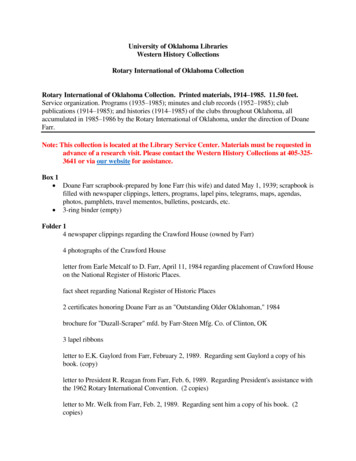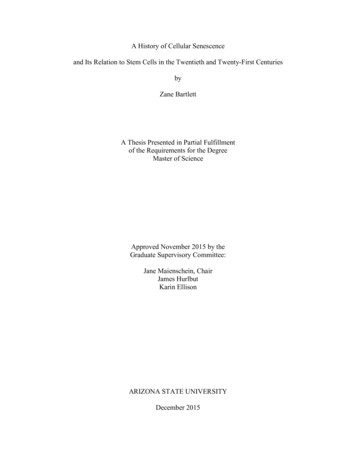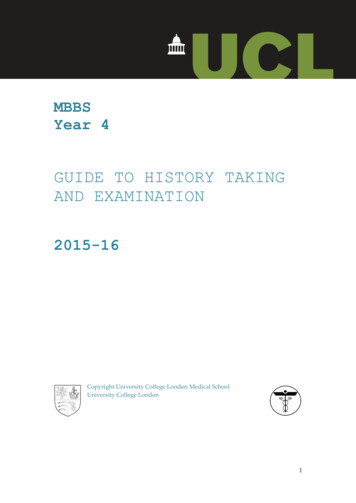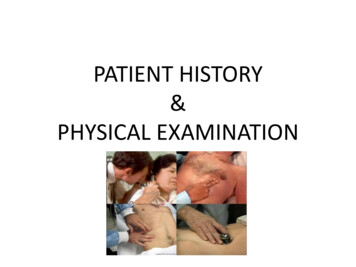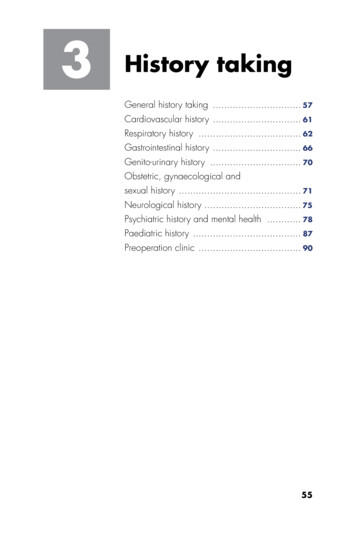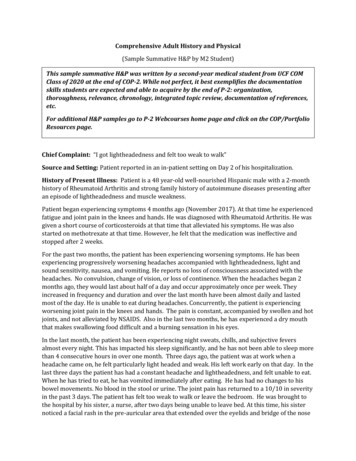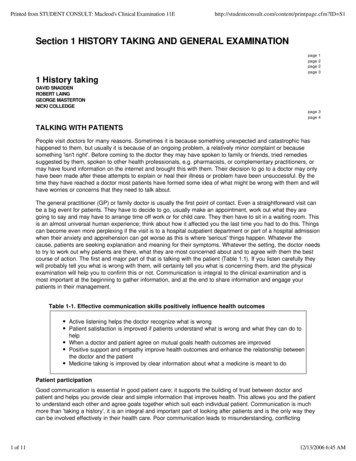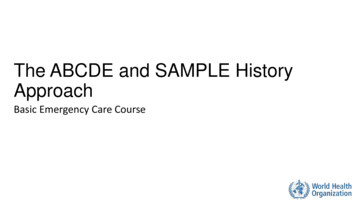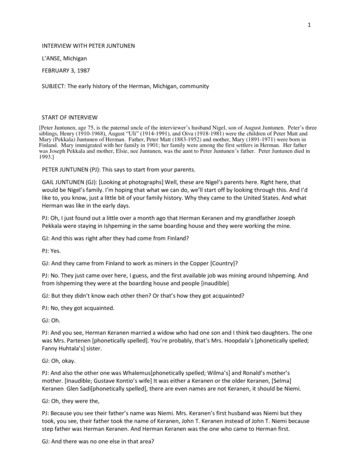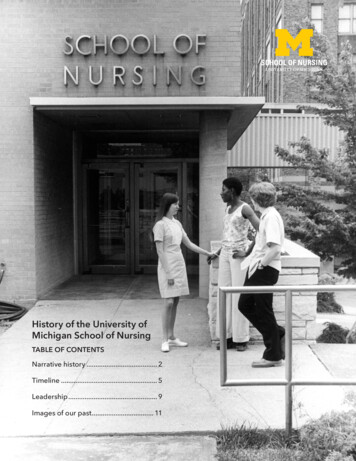
Transcription
History of the University ofMichigan School of NursingTABLE OF CONTENTSNarrative history. 2Timeline. 5Leadership. 9Images of our past. 11
Nurses standing in front of the trainingschool on Catherine Street in Ann ArborNarrative historydiploma program continued until 1952.The relationship between the UniversityHospital and the nursing program wasformalized in 1912, when the University ofMichigan Training School was reorganizedand placed under the administration ofthe University Hospital. In 1915, the firstfull-time instructor was appointed and 130students were enrolled. A four-year highschool diploma was required for admission.The University of Michigan School ofNursing has a rich heritage that is over acentury in the making. Professional nursingeducation began in the United States in1873. The national trend came to Ann Arborin 1891 when the University of MichiganTraining School for Nurses was organized inconjunction with the new University Hospitallocated on Catherine Street in Ann Arbor.In 1919, the first degree program fornursing students was inaugurated as afive-year combined course in letters andnursing. Students spent three years in theCollege of Literature, Science and the Arts,followed by two years in the School ofNursing and received their basic scienceinstruction from the Medical School.The university’s hospital believed it wasincomplete without a nurse training school.The program was two years in length andsix students were admitted in the first year,which was organized and administered bythe Medical School under the direction ofJane Pettigrew. Pettigrew was a trainednurse pursuing medical studies at U-M.In 1923, a 600,000 gift from Senator JamesCouzens provided for the constructionof a nurses’ residence, Couzens Hall.Completed in August of 1925, it had 250rooms, mostly singles, accommodatingabout 260 women. The basement hadfacilities for instruction, an amphitheater,faculty offices, laboratories, classrooms,an assembly hall, and a game room.During this time, education was not theprimary goal of early nursing schools.Most schools were established byhospitals as a way to use student nursesas staff to care for patients, with educationtaking a secondary role. The Universityof Michigan was no exception.In 1902, the Regents extended the Universityof Michigan Training School for Nursesfrom a two-year program to a three-yeardiploma program. Additional nursingprograms started up in the school but theBy its 50th anniversary, the Training Schoolfor Nurses could point with pride to theeducation of over 1,600 nurses. Thatsame year, the Board of Regents created2
In the fall of 1961, the school initiatedits first master’s degree, in psychiatricnursing. In 1962, a Master of Science inmedical-surgical nursing was initiated.This was the first graduate program in theUnited States to prepare clinical nursingspecialists in medical-surgical nursing.The four-year baccalaureate programreceived full accreditation from the NationalLeague for Nursing in 1963. This was thefirst time the program was accreditedfor preparation for first level positions inpublic health. The master’s programs inmedical-surgical and psychiatric nursingwere also fully accredited at this time.Couzens Hall, 1926the faculty of the School of Nursing andgave the title of professor to the director,Rhoda Reddig Russell. The facultyconsisted of one assistant professor and12 instructors. The nursing program wasofficially recognized as an independentuniversity teaching unit, the University ofMichigan School of Nursing (UMSN).By 1965, the school had grown from itsoriginal enrollment of six students in 1891 toa total of 765 students in the baccalaureateprogram and 29 students in the graduateprogram, with a nursing faculty of 75.In 1944, the program in letters and nursingwas discontinued and the Bachelor ofScience in Nursing (BSN) degree programwas initiated. It required completion oftwo years in the College of Literature,Science, and the Arts, followed bythree years in the School of Nursing.By 1970, the school had approximately 1,000students, one of the largest enrollmentsin the nation. The last summer sessionwas held in 1971. The school’s programtransitioned to four regular academic years.In 1975, the school expanded its degreeprograms by offering, for the first time, aresearch-based Doctorate of Philosophy(Ph.D.) in nursing. The University of Michiganwas one of the first in the country to offersuch a degree. In 1987, the Ph.D. programestablished four concentrations in highpriority areas of nursing research andtheory. UMSN was again the first nursingschool in the country to develop suchnursing focal areas, helping to guide thescience and profession of nursing.In 1952, the three-year diploma programand the five-yeardegree program werediscontinued and afour-year program(three calendar yearsand one academicyear) was established.Although the Schoolof Nursing hadRhoda Reddigbeen recognizedRussell, 1940as independentsince 1941, it wasn’t until 1955 that RhodaReddig Russell was appointed as thefirst dean of the school. Until then, theschool operated under the direction ofan administrative committee includingthe hospital and medical school.The school established a Center for NursingResearch in 1984 to serve as the centralcoordinating body for faculty researchand to foster collaborative relationshipswith other units and institutions in relatedresearch. In the following years, new3
master’s programs were developed ingerontological nursing, nurse-midwifery,occupational health nursing, homehealth care, family nurse practitioner, andacute care nurse practitioner. Existingprograms, including nursing administration,psychiatric mental health nursing, andthe undergraduate studies curriculumwere also reviewed and invigorated.at the U-M Center for InterprofessionalEducation, helping to ensure that health careprofessionals from U-M can work creativelyand collaboratively with practitionersfrom all of the health care fields.In 2015, after two years of construction,the School of Nursing Building opened. Itincluded space for classes, faculty and staffoffices, and an expanded Clinical LearningCenter. The 125th anniversary celebrationin April, 2016 highlighted the school’s firstpurpose-built building for nursing education,with integrated technology and state of theart simulation facilities, as well as revealed itsglobal reach. Speakers and attendees fromthe Caribbean to Thailand came togetherfor the school’s Symposium on GlobalHealth: 125 years of research and impact.In 1989, the School of Nursing movedinto renovated space at 400 NorthIngalls, part of the former Saint Joseph’sHospital. This brought the schooltogether under one roof after havingbeen split between Couzens Hall andother buildings in the medical campus.In 1991, the School of Nursing celebrated its100th anniversary of training and educatingfuture nurses. The Honors Program for highability undergraduate students began in1995. In 1996, the school introduced thesecond career nursing program in whichthose with bachelor’s degrees in fields otherthan nursing were able to complete a BSNdegree and prepare for the RegisteredNurse NCLEX exam and licensing in 20months. This program was sunset in 2017.Since 1997, UMSN has been a designatedPan-American Health Organization/WorldHealth Organization Collaborating Center.UMSN remains committed to respondingto the changing social, economic, andscientific landscape as we evolve to bestserve our profession and our students.In 2017, the School of Nursing offers BSN,Master of Science in Nursing (MSN), Ph.D.,and Doctorate of Nursing Practice (DNP)programs in a variety of specializations,showing the remarkable professionalizationof the field in the last 50 years.Recent years have seen a continuedemphasis on driving the science andprofession of nursing. UMSN nowoffers degree programs through threedepartments: Undergraduate Studies,Health Behavior and Biological Sciences,and Systems, Populations and Leadership. Acertification in nursing education preparesand encourages graduate students toteach in schools of nursing, and our facultypartners with others in the health sciences4
TimelineDateHistory1891University of Michigan Training School for Nurses established in response to a growing need forprofessional nurses. School organized and operated under the auspices of the Medical School.Six students admitted on December 7 to a two-year program.1896U-M Homeopathic Hospital Training School for Nurses established with an enrollment of 16students, under the auspices of the Homeopathic Hospital.1902Regents extend program of the University of Michigan Training School to three years. Three-yearprogram maintained until 1952.1912University of Michigan Training School for Nurses reorganized; now the responsibility ofUniversity Hospital. Enrollment: 100 students1915First full-time instructor appointed and enrollment increased to 130 students. Four-year highschool diploma required for admission.1916Enrollment limited to 140 students. Graduating students receive diploma and school pin.Students expected to take State Board Examination for registered nurses. Graduate executivecourses have been in effect for three years; four nurses have earned diplomas.1918Enrollment increases to 180 students.1919First degree program for nursing students established with the inauguration of a five-yearcombined course in letters and nursing. Students spend at least three years in the College ofLiterature, Science, and the Arts (LSA), followed by two years in the School of Nursing.1922Homeopathic Training School merges with the University of Michigan Hospital Training School.1926Through joint arrangement between the hospital and the Medical School, instruction in thebasic sciences in the Medical School now available to students in nursing. Students required tomeet LSA admission requirements. Training School for Nurses becomes a distinct part of theUniversity of Michigan.1928Official name of the Nurse Training School becomes “University Hospital School of Nursing ofthe University of Michigan.” School’s mission is to provide preparation in administration andteaching for nurses in hospitals, schools of nursing, and institutions of various types, as well asactual bedside care of the sick in hospitals and homes.1934School becomes a member of the Association of Collegiate Schools of Nursing.1937Aim of the school “to prepare nurses to meet the community’s varying health needs.” Emphasisis on preparation of the nurse health educator.1940Title of Rhoda Reddig, who holds dual responsibility for nursing education and nursing service,changes from “Director of Nursing Service of University Hospital” to “Director of the School ofNursing and Director of Nursing Service.”5
Timeline continued1941Board of Regents creates faculty of the School of Nursing. Faculty include one assistantprofessor and 12 instructors. Director’s title changes to Professor of Nursing, Director of theSchool of Nursing, and Director of Nursing Service, University Hospital. School officially calledthe University of Michigan School of Nursing. Student admission requirements demand thatstudents graduate in the upper third of their high school class.1944Program in letters and nursing discontinued and new degree program initiated requiring thecompletion of two years in LSA or in another college, followed by three years in School ofNursing. Students graduate with a Bachelor of Science in Nursing.1952More extensive revision of the curriculum. Three-year diploma program and five-year degreeprogram are discontinued and four-year program is established – three calendar years and oneacademic year, leading to the Bachelor of Science in Nursing degree. Curriculum continues tocombines nursing principles and skills with knowledge in liberal arts.1955Rhoda Reddig appointed as first Dean of the School of Nursing.1956718 total students; 95 students graduate with a BSN.1960Total enrollment is 655. School of Nursing bestows 159 BSN degrees, the largest number ofstudents ever graduated from a single nursing school. Faculty totals 55.1961First students admitted to the four-semester master’s program in psychiatric nursing. Programfunded by the National Institute of Mental Health.1962First students admitted to the four-semester master’s program in medical-surgical nursing.Program funded by the W.K. Kellogg Foundation.1963Four-year basic baccalaureate program receives full accreditation from the National League forNursing, including a first-time accreditation for first-level positions in public health. Master’sprograms in medical-surgical and psychiatric nursing also fully accredited at this time.1965Enrollment expanded to a total of 765 students in the baccalaureate program with 26 full-timeand three part-time students in the graduate program. Seventy-five faculty members activelyinvolved in curriculum revision.1966Diamond jubilee of nursing education at the University of Michigan. Since its founding in 1891,2,622 nurses received certificates or diplomas and 1,628 earned BSN degrees. The Horace H.Rackham School of Graduate Studies has granted 27 Master of Science degrees, 16 with a majorin psychiatric nursing and 11 with a major in medical-surgical nursing.1971Rhoda Reddig Russell retires after more than 30 years at the helm of the School of Nursing.Norma Marshall appointed acting dean.1972School receives its first federal monies. “Capitation funds” used to build school’s first computerlab.1973Carolyne Davis assumes the deanship of the School of Nursing. School has enrollment of1,100 undergraduates and employs 115 faculty members. Pediatric nurse practitioner master’sprogram established. Joint program in Nursing Health Services Administration established withthe School of Public Health.6
Timeline continued1975Maxine Loomis assumes acting deanship as Carolyne Davis moves into the position of AssociateVice-President for Academic Affairs at U-M. Doctoral program in nursing established. Firststudents enroll in the master’s program in parent-child nursing.1976Mary Lohr named Professor and Dean at the School of Nursing.1977Master’s program in community health nursing moves from School of Public Health to School ofNursing.1980Pediatric nurse practitioner program subsumed under program in parent-child nursing.1981Rhetaugh Dumas named Professor and Dean at the School of Nursing, the first African AmericanDean at U-M. Size of entering freshman class reduced to 100.1982Assistant Dean for Clinical Affairs position established to serve as liaison between School ofNursing and University Hospital.1983Home health care concentration established. Chronically mentally ill concentration establishedwith a grant from National Institute of Mental Health.1984U-M Center for Nursing Research established and nursing research becomes central to themission of the School of Nursing.1985Center for the Study of Gerontological Nursing established.1987The Ph.D. program established four concentrations in high priority areas of nursing research andtheory. U-M was the first nursing school to develop such nursing focal areas for its students.1988Nursing Simulation Laboratory dedicated. The lab was built with a grant from the Helene FuldHealth Trust.1989School of Nursing moves to its own facility in the 400 North Ingalls Building. For the first time inrecent memory, entire school is housed together. Revamped program in nursing administrationapproved. First students matriculate.1990First ten students enroll in the certified nurse-midwifery program track, the only nurse midwiferyprogram in Michigan.1991School celebrates 100 years of nursing leadership. Dual degree program in nursingadministration and business administration program initiated with a grant from theCommonwealth Fund. Cooperative BSN Program agreement with Jackson Community Collegeestablished.1992The RN to master’s program, a master’s program that combines undergraduate and graduatestudies for registered nurses, initiated.1994Rhetaugh Graves Dumas named Vice Provost for Health Affairs and the Lucille Cole Professor ofNursing at the University of Michigan.1994Ada Sue Hinshaw named Dean and Professor at the School of Nursing.7
Timeline continued1995The honors program for undergraduate students was established. In response to changinghealth care demands, the family nurse practitioner program was developed. Additionally, acutecare practitioner programs for adults and pediatrics also enrolled their first students.1996Second career nursing program, for students with bachelor’s degrees in fields other thannursing, was created to allow students to complete a BSN degree and prepare for theRegistered Nurse NCLEX exam and licensing in 20 months. The program was sunset in 2017.1996The Office of International Affairs was established and Professor Shaké Ketefian was nameddirector. The charge of the office was to provide leadership and facilitation to faculty andstudent exchanges for study and research. A formal visiting scholar program was establishedwithin the office.1997The School of Nursing was designated a Pan American Health Organization-World HealthOrganization Collaborating Center.2001Two new dual degrees in nursing and health policy and nursing and information systems wereinitiated.2005The new Clinical Simulation Labs are officially opened with support from the Provost’s Officeand the University of Michigan Health System.2006Kathleen Potempa named Dean and Professor at the School of Nursing.2007The school achieved 5th place ranking nationally in the, “U.S. News and World Report” rankingof nursing schools, continuing its record placement among the top five nursing programs in theUnited States for over two decades.2009The Doctor of Nursing Practice (DNP) degree program is approved by the faculty.2011The U-M School of Nursing becomes the first nursing school to partner with the Peace Corps inits Peace Corps' Master's International program.2012U-M Board of Regents approved the construction of a new School of Nursing building ofapproximately 75,000 square feet to include instructional spaces, a clinical learning center withsimulation and skill labs, and simulated patient suites.2015The new School of Nursing building opens for the 2015 fall semester. A grand openingceremony, open house and alumni gala were held to celebrate.2016UMSN celebrates its 125th anniversary. Special events held to honor the past and embrace thefuture of nursing education, research, and global impact.2017Michigan state legislature expands the scope of practice for advanced practice registerednurses (APRNs), allowing APRNs, including clinical nurse specialists and nurse-midwives, topractice to the full extent of their training. In doing so, Michigan joins more than 20 other statesto allow full practice authority to APRNs.8
LeadershipNamePositionTimeJane Elizabeth PettigrewHead NurseDec 1891–June 1893Mrs. C. A. DavisHead Nurse/MatronFebruary 1892–June 1892Alice Maud PadfieldHead Nurse/Principal1893–1896Anna Ritchie HarrisonHead Nurse1896–1898Amy Smith MillerDirectress1898–1899Lillian Grace EllsworthSuperintendent1899–1901Helen M BalcomSuperintendent1901–1903Ida M TracySuperintendent1903–1906Mary Catherine HaarerSuperintendent1906–1909Anna Elizabeth WhitelySuperintendent1909–1910Luella BristolSuperintendent1910–1911Elizabeth Winnifred HoltSuperintendent1911–1913Jane Maulsby PindellSuperintendent1913–1915Fantine C PembertonSuperintendent1915–1918Mary Anorah WelshSuperintendent1918–1922Anna Louise GliemActing Superintendent1922–1923Alice Livea Lake1923 – Superintendent1923–1925April 1924 – Director of NursingShirley Carew TitusDirector of Nursing1925–1930Marian DurellDirector of Nursing1930–19409
Leadership continuedNamePositionTimeRhoda Reddig Russell1940 – Director of the Schoolof Nursing and Directorof Nursing
century in the making. Professional nursing education began in the United States in 1873. The national trend came to Ann Arbor in 1891 when the University of Michigan . completion of two years in LSA or in another college, followed by three years in School of Nursing. Students graduate with a Bachelor of Science in Nursing.
